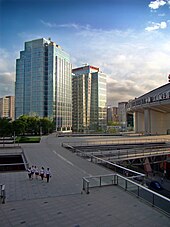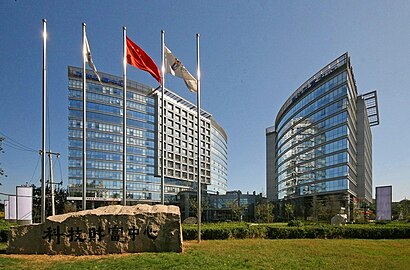Zhongguancun

Zhongguancun (simplified Chinese: 中关村; traditional Chinese: 中關村; pinyin: Zhōngguāncūn), or Zhong Guan Cun, is a technology hub in Haidian District, Beijing, China.
It is geographically situated in the northwestern part of Beijing city, in a band between the northwestern Third Ring Road and the northwestern Fourth Ring Road. Zhongguancun is very well known in China, and is often referred to as "China's Silicon Valley".[1]
History

Zhongguancun has only existed since the 1950s and only became a household name in the early 1980s. The first person who envisioned the future for Zhongguancun was Chen Chunxian, a member of the Chinese Academy of Sciences (CAS), who came up with the idea for a Silicon Valley in China after he visited the U.S. as part of a government-sponsored trip. The location of the Chinese Academy of Sciences within Zhongguancun reinforced, and perhaps was in part responsible for the technological growth in this area.
Throughout the 1980s and still today, Zhongguancun was known as "electronics avenue," because of its connections to information technology and the preponderance of stores along a central, crowded street.
Zhongguancun was officially recognized by the central government of China in 1988. It was given the wordy name "Beijing High-Technology Industry Development Experimental Zone."
The current designation Zhongguancun refers commonly to the original site. However, officially (as of 1999) Zhongguancun has become the "Zhongguancun Science & Technology Zone." It is a zone with seven parks, including Haidian Park, Fengtai Park, Changping Park, Electronics City (in Chaoyang), Yizhuang Park, Desheng Park, and Jianxiang Park.
The original Zhongguancun is now known as the Haidian Park of the Zhongguancun Zone. The area and environs, however, remain the same.
Notable areas


Hailong Market, Guigu Market, Taipingyang Market, Dinghao Market and Kemao Market are the five prominent IT and electronics markets. They are technology bazaars, famous for their "shops with a shop", where prices are easily but grudgingly bargained. Zhongguancun shops mainly deal in PC-compatible hardware, peripherals and software. AppleCentre and Apple Experience Centre are also close by.
A very particular sight to visit is the Haidian Christian Church, designed by Hamburg-based architects Gerkan, Marg and Partners.[2]
Notable education and research centres
Due to the proximity and participation of China's two most prestigious universities, Peking University and Tsinghua University, along with the Chinese Academy of Sciences, many analysts elsewhere are optimistic about Zhongguancun's future prospects.
Notable high schools in Zhongguancun include Affiliated High School of Peking University and High School Affiliated to Renmin University of China.
Government and infrastructure
The State Administration of Foreign Experts Affairs (SAFEA) has its headquarters in Zhongguancun.[3]
Notable companies
The most famous companies that grew up in Zhongguancun are Stone Group, Founder Group, and Lenovo Group. They were all founded in 1984-85. Stone was the first successful technology company to be operated by private individuals outside the government of China. Founder is a technology company that spun off Peking University. Lenovo Group spun off from Chinese Academy of Sciences with Liu Chuanzhi, a hero of Zhongguancun and current Chairmain, eventually taking the helm. Lenovo purchased IBM's PC division with $1.75 billion in 2005, making it the world's third-largest PC maker. Both Founder and Lenovo Group maintain strong connections to their academic backers, who are significant shareholders.
According to the 2004 Beijing Statistical Yearbook, there are over 12,000 high-tech enterprises throughout Zhongguancun's seven parks, with 489,000 technicians employed.
Eastdawn Corporation is in the Sinosteel building.
Many world-renowned technology companies built their Chinese headquarters and research centers in Zhongguancun Technology Park, such as Google, Intel, AMD, Oracle Corporation, Motorola, MySpace, Sony, Solstice, and Ericsson. Microsoft has built its Chinese research headquarters in the park that costs $280 million and can accommodate 5000 employees, which was completed in April, 2011, and now houses Microsoft Research Asia.[4]
The development center of Loongson, which is China's first general-purpose microprocessor design, is also in the Zhongguancun area.[5]
In addition, many conferences are held in this location, including the annual ChinICT conference - which is the largest Information technology Development and Entrepreneurship event in China.
-
Near to Tuspark
Transportation
Beijing Subway Line 4 runs through the Zhongguancun area with stops at Zhongguancun Station and Haidianhuangzhuang Station. Haidianhuangzhuang is also a transfer station with Line 10. In addition to the subway, Zhongguancun is served by many of Beijing's public buses- 26, 302, 304, 307, 332, 333, 355, 365, 384, 386, 466, 498, 549, 579, 584, 601, 608, 611, 614, 630, 634, 641, 653, 671, 681, 689, 696, 697, 699, 717, 740, 913, 944, 982, 983, 特4, 特6, 特9, 特15, 特18, 夜8, 夜9, 运通105, 运通106, 运通109, 运通110, and 运通113.
See also
- List of technology centers around the world
- China Beijing Equity Exchange
- China Milan Equity Exchange
- Zhongguancun Administrative Committee
References
- ^ "Zhongguancun, China's Silicon Valley".
- ^ Zhongguancun Christian Church
- ^ Home. State Administration of Foreign Experts Affairs. Retrieved on July 12, 2017. "邮编:100873 地址:北京中关村南大街一号5号楼 "
- ^ "Microsoft Research Asia".
- ^ Institute Of Computing Technology Chinese Academy Of Sciences Archived September 19, 2009, at the Wayback Machine



